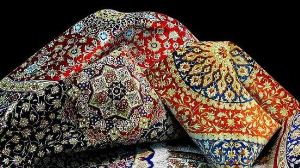 Many Persian carpet weavers who had abandoned the profession in recent years because the business was no longer profitable have been setting up looms again as a surge in demand and a�plunge in the value of the Iranian currency, the rial, has led to an increase in the prices of the handmade carpets.
Many Persian carpet weavers who had abandoned the profession in recent years because the business was no longer profitable have been setting up looms again as a surge in demand and a�plunge in the value of the Iranian currency, the rial, has led to an increase in the prices of the handmade carpets.A 60 per cent surge in the prices fuelled hope that the key industry, which employs 1m Iranians, might be on the way to recovery, experts say. Moreover, Iranians, who have been converting their rials into hard currencies and gold coins over the past year on fears of losing the value of their savings, are also buying more carpets as a hedge against inflation.
�Many carpet workshops, which were shut down, have resumed production, especially in the second half of last year (September 23, 2012-March 20, 2013),� says Abdullah Bahrami, managing director of Union of Iran Carpet Producers Company, a state-run body supplying raw materials to carpet weavers.
Demands for raw material rose by more than 100 per cent during the same period because the prices of carpets are expected to rise even more, he adds.
Low demand and low prices have forced�many carpet makers to leave the profession. Their numbers have dropped from 2m in early 2000s to about 1m in recent years.
Other experts, however, warn that it is too early to declare a full recovery of the industry. Carpet weavers still have to cope with the increasing cost of imported raw materials such as wool, thread and silk, which are usually brought from New Zealand and China. The prices have increased at least three times since last year, according to Mr Bahrami, because of the 50 per cent drop in the value of the rial.
Moreover, in spites of the positive signals in the carpet industry, there are concerns that the gloomy economic outlook and the continuous international sanctions could hinder real and long-lasting boom in the industry. And it not yet clear whether the initial positive trend will eventually lead to an increase in exports, a key to a healthy revival of the industry.
Carpet exporters complain that their customers have not been particularly encouraged by the devalued rial. The main reason for this is sanctions, which were imposed in 2010 when the US enhanced trade restrictions which included the rescission of the authorisation for Iranian-origin imports for articles such as rugs, pistachios and caviar.
The sanctions have led to a dramatic 30 per cent drop of carpet exports, which was the US share of Iran�s market, the main export destination. Iran�s competitors China, India, Pakistan and Turkey, have subsequently filled the gap left in the US.
Furthermore, the economic crisis in the Europe and the Arab uprisings have led to a decline in demand from these regions for Iranian carpets. The country�s export earnings from carpets slid about 18 per cent in the first 10 months of last Iranian year compared with the same period of the previous year, according to Iran�s ministry of industries.
Nevertheless, Iranian exporters insist the country is still the world�s leading exporter and over 70 per cent of its output ends up in more than 50 countries including Germany, the Gulf states, Japan, China and Russia.
�Despite the world�s bad economic situation and other problems, Iran�s exquisite carpet still has its own market thanks to its unique design, colour and quality,� says said Morteza Araghchi, a leading carpet exporter.
By The Financial Times
The Iran Project is not responsible for the content of quoted articles.










